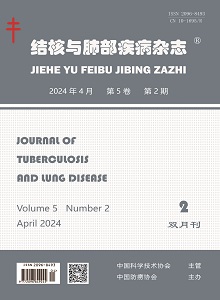-
Analysis of mental health status of floating population with tuberculosis in Haizhu district of Guangzhou city
- ZHANG Ke-xun, LI Pei-zhu, PENG Feng-ling, TAN Shou-yong, LIU Jian-xiong, HE Li-qian, LIN Yin, CHEN Qi-chen
-
Journal of Tuberculosis and Lung Health. 2013, 2(3):
185-188.
doi:10.3969/j.issn.2095-3755.2013.03.011
-
 Abstract
(
357 )
Abstract
(
357 )
 PDF (797KB)
(
395
)
PDF (797KB)
(
395
)
 Save
Save
-
References |
Related Articles |
Metrics
Objective To investigate the mental health status of floating population with tuberculosis in order to provide evidence-based psychological treatment and health education.Methods We investigated the mental health status of 173 cases of floating population with tuberculosis by the symptom checklist (SCL-90), and made comparison with 1388 cases of national norm. EpiData 3.0 software is used for setting up the database and data entry. PASW 18.0 is used for statistical analysis.Results SCL-90 shows the experimental group has lower scores in somatic(score 1.24±0.36), compulsive (score 1.40±0.36), depressed (score 1.36±0.33) and psychotic symptoms factor (1.15±0.26) compared to the domestic norm(scores respectively 1.37±0.48, 1.62±0.52, 1.50±0.59, 1.29±0.42). The differences are statistically significant (t values is -5.20, -8.71, -5.95, -7.83, P<0.01). Score in interpersonal sensitivity, anxiety, and hostile factor (respectively 1.71±0.48, 1.57±0.54, 1.56±0.54) is higher than domestic norm(respectively 1.65±0.61, 1.39±0.43, 1.46±0.55). The differences are statistically significant (t values is 2.24, 4.58, 2.73, P<0.01). By using multivariate analysis, we find that interpersonal sensitivity is related to annual income, patient category and with or without lung cavity (patients with annual incomes between 5000 to 10000 yuan, Wald χ2=20.916,P<0.001,OR=0.035,95%CI:0.008-0.147; patients with annual incomes of between 10000 to 15000 yuan, Wald χ2=1.146,P=0.284,OR=0.393,95%CI=0.071-2.171; patients with annual incomes of 15000 to 20000 yuan, Wald χ2=0.317,P=0.573,OR=0.731,95%CI=0.246-2.174; patients with annual incomes of more than 20000 yuan, Wald χ2=6.145,P=0.013,OR=0.247,95%CI=0.081-0.746; for previously treated patients, Wald χ2=4.321,P=0.038,OR=0.248,95%CI=0.067-0.924; for patients with lung cavities, Wald χ2=4.123,P=0.042,OR=2.321,95%CI=1.030-5.232). The anxiety factor is related to annual income (annual income between 5000-10000 yuan, Wald χ2=14.047, P<0.001, OR=0.016,95%CI: 0.002-0.130; annual income of 15000-20000 yuan, Wald χ2=1.650, P=0.199, OR=2.083,95%CI=0.680-6.370; annual income of more than 20000 yuan, Wald χ2=4.934, P=0.026, OR=0.253,95%CI=0.075-0.850).Conclusion Migrant patients’ mental health status is relevant to patients’ illness condition, patient category and annual income. In general, the mental health status of floating population with tuberculosis is relatively low. Therefore, mental therapy should be provided.

 Wechat
Wechat